By Kay Ledbetter
AgriLife Extension helps add alfalfa to list of crops treated by Topguard Terra
This year, when alfalfa growers start seeing the menacing cotton root rot showing up in their fields, they can rest assured that almost 120 years after it was first characterized, Texas A&M AgriLife researchers have helped find a control for the fungus.

This alfalfa field shows the significant difference between the untreated left side and treated right side.
The cotton root rot fungus, Phymatrotrichopsis omnivora, attacks multiple plant species in the alkaline soils of the southwestern U.S., including cotton, grape and alfalfa. This disease, also called Texas root rot, TRR, rots the tap roots, causing plants to wilt and eventually die, leaving dry, brown leaves stuck to the stems.
David Drake, Ph.D., Texas A&M AgriLife Extension Service integrated pest management agent, Commerce, has conducted trials on alfalfa with the fungicide Topguard Terra, with the active ingredient flutriafol, since 2011.
Although not large in acreage compared to row crops, Drake said alfalfa is grown throughout Texas and is especially important to the dairy and livestock industry. In 2019, the value of alfalfa in Texas was estimated at $100 million.
Topguard Terra was given a section 24 label by the Texas Department of Agriculture to control root rot in cotton in 2012 and has been used successfully since, Drake said. A 24C local-needs registration was also granted for use on grapes in 2015.
Now, finally, in 2020, a supplemental label has been granted for the use of Topguard Terra on alfalfa in eight states.
AgriLife Extension finds the needed ingredient
The active ingredient in Topguard Terra, flutriafol, was the first and only active ingredient found to provide satisfactory control of cotton root rot in field trials of cotton or any other crop.
Credit for finding the product goes to Tom Isakeit, Ph.D., AgriLife Extension plant pathologist, College Station, and Rick Minzenmayer, AgriLife Extension integrated pest management specialist, Ballinger, who conducted a product screening program in San Angelo for many years.
TRR in alfalfa results in low hay production and bare areas where weeds can grow and contaminate hay, Drake said.
“What makes it more devastating is that farmers invest hundreds of dollars in alfalfa seed expecting the field to last five or more years and TRR can wipe out large areas of a field in a single year,” he said.

Alfalfa hay samples from treated and untreated areas
Application information
In alfalfa, Topguard Terra is soil or stubble applied to protect plant roots. Drake’s research has shown good results with spring broadcast applications and between cutting applications as late as July.

A 2-year-old alfalfa stand infected with Texas root rot. Producers typically get five years from a stand.
“Earlier is better, as is the case with many soil-applied crop protection products that take irrigation or precipitation to be moved into the soil,” he said.
Drake said Topguard Terra should be applied to fields with a history of TRR in alfalfa, cotton or other crops. This disease tends to appear in the same areas year after year. Preventive treatments in areas known to have root rot will protect alfalfa stands. Annual treatments of already-diseased alfalfa fields will result in healthier plants and reduced spread of the disease.
Early research on alfalfa showed some protection with annual applications of 4 or 8 fluid ounces of Topguard Terra with the higher rates giving more consistent results, he said. Higher rates should be used in areas with active root rot or historically severe root rot and on heavier soils.
The label has expanded applications that allow two treatments per year not to exceed 12 fluid ounces per application and 19.5 fluid ounces per growing season. More research is currently being done on split applications, Drake said. He stressed producers need to read and follow all label guidelines.
“Some producers with the use of aerial mapping and site-specific application will be able to reduce costs by applying the fungicide only to portions of the field that are affected by the disease,” he said. “This technology is being used for TRR in cotton.”
Click here to see more...